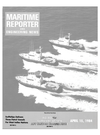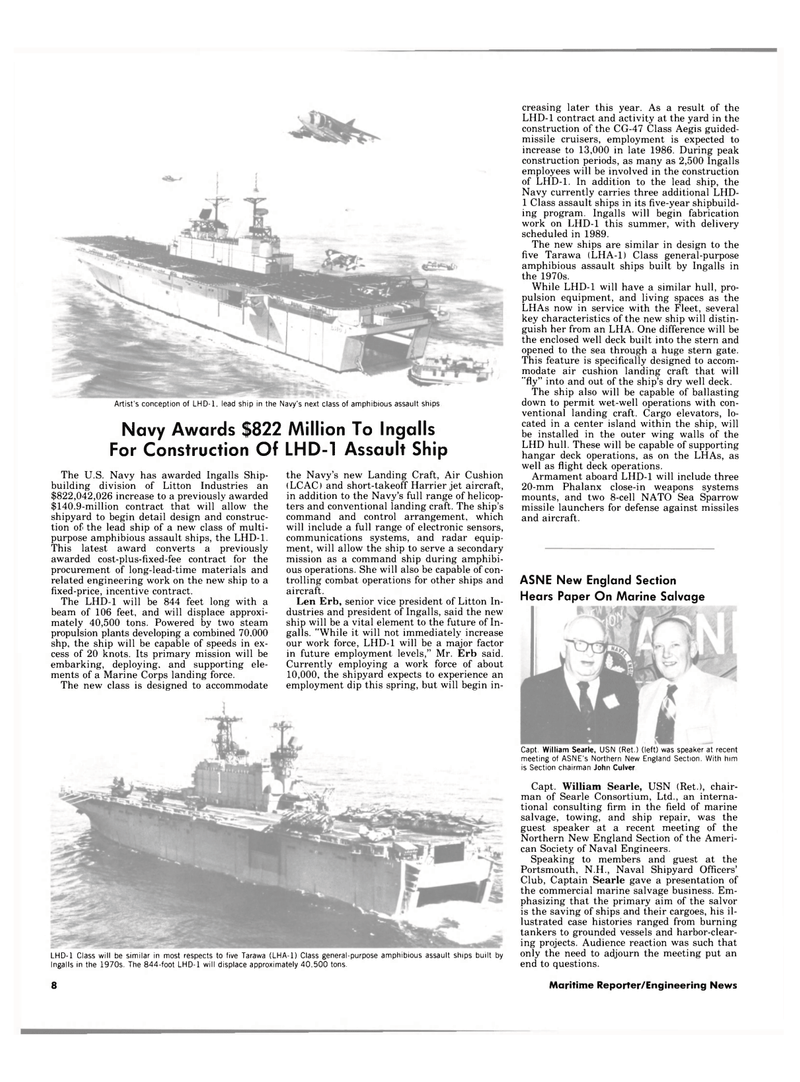
Page 6: of Maritime Reporter Magazine (April 15, 1984)
Read this page in Pdf, Flash or Html5 edition of April 15, 1984 Maritime Reporter Magazine
Artist's conception of LHD-1, lead ship in the Navy's next class of amphibious assault ships
Navy Awards $822 Million To Ingalls
For Construction Of LHD-1 Assault Ship
The U.S. Navy has awarded Ingalls Ship- building division of Litton Industries an $822,042,026 increase to a previously awarded $140.9-million contract that will allow the shipyard to begin detail design and construc- tion of the lead ship of a new class of multi- purpose amphibious assault ships, the LHD-1.
This latest award converts a previously awarded cost-plus-fixed-fee contract for the procurement of long-lead-time materials and related engineering work on the new ship to a fixed-price, incentive contract.
The LHD-1 will be 844 feet long with a beam of 106 feet, and will displace approxi- mately 40,500 tons. Powered by two steam propulsion plants developing a combined 70,000 shp, the ship will be capable of speeds in ex- cess of 20 knots. Its primary mission will be embarking, deploying, and supporting ele- ments of a Marine Corps landing force.
The new class is designed to accommodate the Navy's new Landing Craft, Air Cushion (LCAC) and short-takeoff Harrier jet aircraft, in addition to the Navy's full range of helicop- ters and conventional landing craft. The ship's command and control arrangement, which will include a full range of electronic sensors, communications systems, and radar equip- ment, will allow the ship to serve a secondary mission as a command ship during amphibi- ous operations. She will also be capable of con- trolling combat operations for other ships and aircraft.
Len Erb, senior vice president of Litton In- dustries and president of Ingalls, said the new ship will be a vital element to the future of In- galls. "While it will not immediately increase our work force, LHD-1 will be a major factor in future employment levels," Mr. Erb said.
Currently employing a work force of about 10,000, the shipyard expects to experience an employment dip this spring, but will begin in- creasing later this year. As a result of the
LHD-1 contract and activity at the yard in the construction of the CG-47 Class Aegis guided- missile cruisers, employment is expected to increase to 13,000 in late 1986. During peak construction periods, as many as 2,500 Ingalls employees will be involved in the construction of LHD-1. In addition to the lead ship, the
Navy currently carries three additional LHD- 1 Class assault ships in its five-year shipbuild- ing program. Ingalls will begin fabrication work on LHD-1 this summer, with delivery scheduled in 1989.
The new ships are similar in design to the five Tarawa (LHA-1) Class general-purpose amphibious assault ships built by Ingalls in the 1970s.
While LHD-1 will have a similar hull, pro- pulsion equipment, and living spaces as the
LHAs now in service with the Fleet, several key characteristics of the new ship will distin- guish her from an LHA. One difference will be the enclosed well deck built into the stern and opened to the sea through a huge stern gate.
This feature is specifically designed to accom- modate air cushion landing craft that will "fly" into and out of the ship's dry well deck.
The ship also will be capable of ballasting down to permit wet-well operations with con- ventional landing craft. Cargo elevators, lo- cated in a center island within the ship, will be installed in the outer wing walls of the
LHD hull. These will be capable of supporting hangar deck operations, as on the LHAs, as well as flight deck operations.
Armament aboard LHD-1 will include three 20-mm Phalanx close-in weapons systems mounts, and two 8-cell NATO Sea Sparrow missile launchers for defense against missiles and aircraft.
ASNE New England Section
Hears Paper On Marine Salvage
Capt. William Searle, USN (Ret.) (left) was speaker at recent meeting of ASNE's Northern New England Section. With him is Section chairman John Culver
Capt. William Searle, USN (Ret.), chair- man of Searle Consortium, Ltd., an interna- tional consulting firm in the field of marine salvage, towing, and ship repair, was the guest speaker at a recent meeting of the
Northern New England Section of the Ameri- can Society of Naval Engineers.
Speaking to members and guest at the
Portsmouth, N.H., Naval Shipyard Officers'
Club, Captain Searle gave a presentation of the commercial marine salvage business. Em- phasizing that the primary aim of the salvor is the saving of ships and their cargoes, his il- lustrated case histories ranged from burning tankers to grounded vessels and harbor-clear- ing projects. Audience reaction was such that only the need to adjourn the meeting put an end to questions. LHD-1 Class will be similar in most respects to five Tarawa (LHA-1) Class general-purpose amphibious assault ships built by Ingalls in the 1970s. The 844-foot LHD-1 will displace approximately 40,500 tons. 8 Maritime Reporter/Engineering News

 5
5

 7
7
